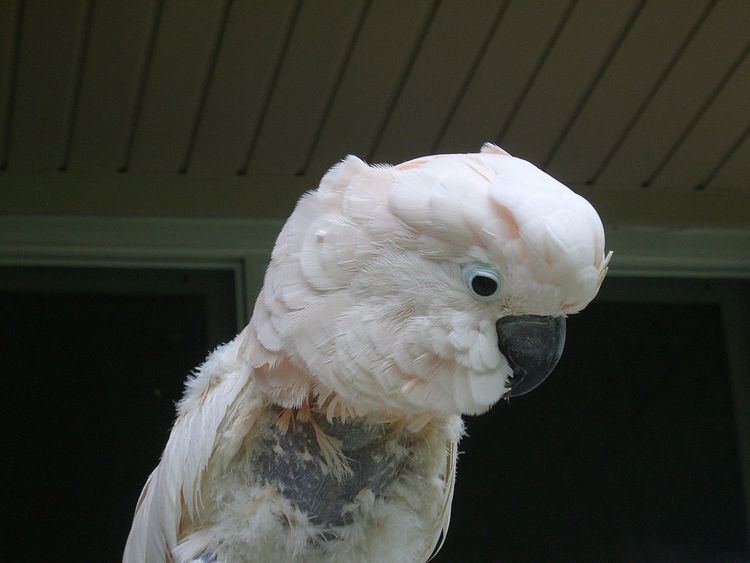 | ||
Feather-plucking, sometimes termed feather-picking, feather damaging behaviour or pterotillomania, is a maladaptive, behavioural disorder commonly seen in captive birds which chew, bite or pluck their own feathers with their beak, resulting in damage to the feathers and occasionally the skin. It is especially common among Psittaciformes, with an estimated 10% of captive parrots exhibiting the disorder. The areas of the body that are mainly pecked or plucked are the more accessible regions such as the neck, chest, flank, inner thigh and ventral wing area. Contour and down feathers are generally identified as the main target, although in some cases, tail and flight feathers are affected. Although feather-plucking shares characteristics with feather pecking commonly seen in commercial poultry, the two behaviours are currently considered to be distinct as in the latter, the birds peck at and pull out the feathers of other individuals.
Contents
- Causes
- Early experience
- Isolation
- Barren environment
- Re directed foraging behaviour
- Stress
- Medical and physical factors
- Neurobiological factors
- Genetic factors
- Treatment
- References
Feather-plucking has characteristics that are similar to trichotillomania, an impulse control disorder in humans, and hair-pulling which has been reported in mice, guinea pigs, rabbits, sheep and muskox, dogs and cats, leading to suggestions for a comparative psychology approach to alleviating these problems.
Causes
Feather-plucking is generally regarded as a multifactorial disorder, although three main aspects of bird keeping may be related to the problem: (1) cage size often restricts the bird’s movements; (2) cage design and barrenness of the environment often do not provide sufficient behavioural opportunities to meet the bird's sensitivity, intelligence and behavioural needs; and (3) solitary housing, which fails to meet the high social needs of the bird.
Early experience
Isolation
Barren environment
Re-directed foraging behaviour
Stress
Medical and physical factors
Many medical causes underlying the development of feather-plucking have been proposed including allergies (contact/inhalation/food), endoparasites, ectoparasites, skin irritation (e.g. by toxic substances, low humidity levels), skin desiccation, hypothyroidism, obesity, pain, reproductive disease, systemic illness (in particular liver and renal disease), hypocalcaemia, psittacine beak and feather disease (PBFD), proventricular dilatation syndrome, colic, giardiasis, psittacosis, airsacculitis, heavy metal toxicosis, bacterial or fungal folliculitis, genetic feather abnormalities, nutritional deficiencies (in particular vitamin A) and/or dietary imbalances, and neoplasia. For many of the above-mentioned factors, a causative relationship or correlation has not been established and may therefore merely be the result of coincidental findings.
Approximately 50% of parrots exhibiting feather damaging behaviour have been diagnosed as having inflammatory skin disease based on paired skin and feather biopsies. The birds try to relieve itching by grooming their feathers, but this often leads to over-grooming and eventually feather-plucking.
Neurobiological factors
Little is currently known on brain dysfunction in feather-plucking. However, it may be hypothesized that abnormal brain function is involved, especially in those cases that appear sensitive to treatment with behavioural intervention and/or environmental changes. Psychotropic therapy for birds has been suggested as treatment for feather-plucking although responses seem variable.
Genetic factors
In orange-winged amazon parrots, a heritability estimate of 1.14 ± 0.27 was found for feather-plucking, indicating that a genetic basis exists. This study, however, only involved analysis of full siblings and a small number of birds, explaining the heritability value of greater than 1. Quantitative trait loci (QTL) analysis could provide more insight in possible genetic markers that are involved in feather-plucking.
Treatment
Veterinary treatment or an improved and more stimulating environment may help birds suffering from feather-plucking. Organic bitter sprays are sold in pet stores to discourage plucking, especially of newly grown feathers, although this may make general beak-based grooming difficult for the animal. This is not recommended since it doesn't address the real reason why the bird is picking feathers.
